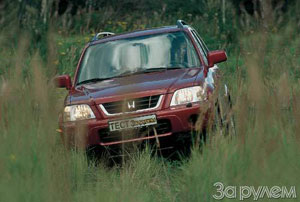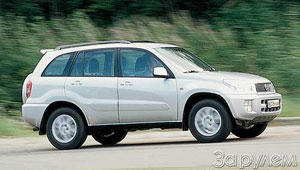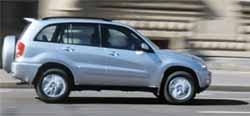Test drive Honda CR-V 1996-2001 SUV
Leg in the leg
When the technical level of rivals is so close, their duel is of particular interest. Toyota -rav4 at one time not only surprised everyone with the unusual design, but also founded a whole class of her own kind - parquet all -terrain vehicles. Now its second generation enters the market, and the main rival - the Honda CR -V appeared a little later modernized. Which of the two has succeeded?
Toyota -rav4 at one time not only surprised everyone with the unusual design, but also founded a whole class of her own kind - parquet all -terrain vehicles. Now its second generation enters the market, and the main rival - the Honda CR -V appeared a little later modernized. Which of the two has succeeded? Toyota-Rav4 was represented in the spring of 1994 in a three-door version. A year later, a modification with five doors appeared, and another and a half later the engine power was increased and the appearance changed slightly. The new generation of cars debuted in the spring of 2000, and in the summer sales in Russia began. It is produced with a three- and five-door body, gasoline motors with a volume of 2 or 1.8 liters, an automatic or mechanical gearbox, a drive for everything (2 l) or only on the front wheels (1.8 l).
Honda CR-V was first shown in Tokyo in the fall of 1995. A modernized machine with a more powerful engine, an extended list of standard equipment and an updated salon appeared in 1998, and in our market about a year ago. It is produced only with a five -door body and two -liter gasoline engine; box - automatic or mechanical; A drive to everything or only on the front wheels.
What do they have in common?
 Much more than you might think at first glance. A carrier body, a transverse engine (two -liter sixteen -valve four), an independent suspension of all wheels and all -wheel drive. Although - stop. There are enough differences too. At first glance, Honda is noticeably longer and has a completely flat floor.
Much more than you might think at first glance. A carrier body, a transverse engine (two -liter sixteen -valve four), an independent suspension of all wheels and all -wheel drive. Although - stop. There are enough differences too. At first glance, Honda is noticeably longer and has a completely flat floor. If you look from below, there are even more differences. Toyota has a front suspension - such as McEferson, Honda has double transverse levers. Behind, with a formally close multi -link scheme, the location, kinematics and the design of the levers are completely different. Honda’s multi -link resembles the one on Sivik, and Toyota’s one that is on Selik. Full -wheel drive is also realized in different ways: in Toyota it is constant, in Honda only the front wheels always serve as leading - the rear are connected automatically only if necessary.
Since acquaintance with cars began with such an unusual angle, why not measure the road clearance? Having checked the pressure in the tires, we load cast -iron flashes to the salon and trunk to the required full mass and again climb under the cars. Once! Still, it is not for nothing that they are called parquet: Honda’s road clearance is 148 mm, for Toyota - 145 (and it is declared 205 mm for both). Well, who is better? Let's take a closer look: the first car has the lowest part - a muffler in the middle of the wheeled base, the second is the receiving pipe of the exhaust system in the area of \u200b\u200bthe front bridge. If you measure the clearance under the levers of the suspension, then the position of Honda is a little better, especially taking into account the smaller diameter of the wheels. It is worse that she has a larger wheelbase and total length.
 The crossed terrain should be flat!
The crossed terrain should be flat! Even such a rather cursory look makes you think about the consequences of the congress from the road. So you should not trust the potential of cars, but your own cars.
Thanks to the complete drive, both cars successfully overcome slippery herbal slopes, loose sand and feel good on a not too broken primer. Under such conditions, standard tires with a traffic road pattern serve as a natural driver ambition limiter. Replacing them with more toothy rubber will increase not so much patency as the risk of damaging the silencer or suspension.
We did not set a goal to determine the leader in patency, but we came to the conclusion that both Honda and Toyota are enough for lovers of picnic in nature and relaxing in the village, not too far from roads. Winter with its snowfalls and poorly cleaned courtyards is the best time to evaluate the advantages of parquet. It is better to look for excited hunters and fishermen to look for an all -wheel drive car, more seriously prepared for the assault on the road.
Features of national parquet
 Well, let the parquet, but the quality of the parquet is sharply different from what is common in the historical homeland of Toyota and Honda. However, it is here that the all -resistant capabilities of cars are revealed in full force. Large wheels, tires with a high profile, fairly hard suspensions allow you not to notice the coating defects, except, perhaps, the largest. It is good that even high wheels are almost not transferred to the steering wheel and do not knock down the car from the course. Both cars are able to drive along a broken or wavy asphalt much faster than simple cars.
Well, let the parquet, but the quality of the parquet is sharply different from what is common in the historical homeland of Toyota and Honda. However, it is here that the all -resistant capabilities of cars are revealed in full force. Large wheels, tires with a high profile, fairly hard suspensions allow you not to notice the coating defects, except, perhaps, the largest. It is good that even high wheels are almost not transferred to the steering wheel and do not knock down the car from the course. Both cars are able to drive along a broken or wavy asphalt much faster than simple cars. For alternate, behavior on the asphalt of Toyota and Honda can be recognized as ideal, which does not mean the same at all. Honda suspension is noticeably softer and offers passengers more comfort. The reckoning of this is a little slow reactions and large rolls. Toyota against such a background is an almost sports car: he abruptly and without delay obey the driver's requirements and equally punctually monitors the profile of the road. As if apologizing for the cocky sports character, the Toyota suspension is less noisy commenting on especially large pits and potholes.
An attempt to enter the turn at high speed both cars generously forgive, but again in different ways. Honda, which has a noticeable insufficient rotation, is boring to admit: it would be more precise ... more neutral in the turn of Toyota drifts all four, and then sharply stabilizes, as if mockery of you: well, a swordfile?
 Faster, it means better?
Faster, it means better? This is what the case is on the dynamometric road of the landfill. With engines, almost equal in power and volume, our rivals should have almost the same possibilities. The selection of gear rates in transmission, mass and aerodynamics will be decisive. The Honda is 56 kg heavier, lobster, it has a larger lobe area (Midel, if we use the terminology adopted in aerodynamics). The result is logical: Toyota leads, gradually turning a minimum starting advantage into a noticeable (after 140 km/h) separation. But the jerk for overtaking (in the range of 80-120 km/h) Honda is better. However, categorical conclusions would not be entirely correct: Toyota managed to run over several thousand kilometers before our test, while Honda had to stand up for the honor of the brand, running a little more than a hundred.
Despite not the highest grip qualities of tires, both cars showed very good ones, and for all -terrain vehicles - just outstanding braking results with an average deceleration of more than 9 m/s2. Bracing with 100 km/h, Toyota was half a corps behind Honda, which helped her earn additional glasses.
Light oranges by barrels
 And do not forget about the internal volume. Although Honda’s size is clearly larger, its capacity turned out to be almost the same as Toyota’s. The luggage compartment CR-V is noticeably longer, but no more in volume. The secret in the unique low level of the Toyota floor, due to which the loading height is 205 (!) Mm lower than that of Honda. In its defense, Honda can offer a folding table for a picnic hidden under the rug of the luggage compartment, and a special recess under it, which is enough, for example, for a dosage spurt (a full-fledged reserve in a beautiful plastic case of both machines is located on the rear door).
And do not forget about the internal volume. Although Honda’s size is clearly larger, its capacity turned out to be almost the same as Toyota’s. The luggage compartment CR-V is noticeably longer, but no more in volume. The secret in the unique low level of the Toyota floor, due to which the loading height is 205 (!) Mm lower than that of Honda. In its defense, Honda can offer a folding table for a picnic hidden under the rug of the luggage compartment, and a special recess under it, which is enough, for example, for a dosage spurt (a full-fledged reserve in a beautiful plastic case of both machines is located on the rear door). The numbers are numbers, and the subjective feeling of the spaciousness of the salon is clearly in favor of Honda - due to the low window line, elegant and compact seats, large width. Three passengers in the back seat are freer here. Although people tall above the average in Honda are not so convenient - less the course of longitudinal adjustment of the seats, below the ceiling. True, the latter can be attributed to a large sliding hatch in the roof.
 Toyota, on the contrary, does not seem spacious, although it is more desirable for high drivers - the course of longitudinal adjustment of the seat is quite large. A small sports steering wheel is located closer to the vertical, which, together with the dashboard, in the center of which is a tachometer, gives the driver's sector a racing courage.
Toyota, on the contrary, does not seem spacious, although it is more desirable for high drivers - the course of longitudinal adjustment of the seat is quite large. A small sports steering wheel is located closer to the vertical, which, together with the dashboard, in the center of which is a tachometer, gives the driver's sector a racing courage. To whom and why?
At a price of more than 30 thousand dollars, both cars cannot be called cheap. A high level of quality and technology was never sold for pennies, especially in such a young and fashionable market segment, the real competition in which was only outlined. Nevertheless, both cars are in demand, and not only abroad. Perhaps the difference is that Russian buyers of all -terrain vehicles of this class are noticeably older than European or American colleagues. The new, stylish and serious appearance of Toyota should help her significantly expand the list of potential customers - with age, people begin to prefer the style of windy fashion. Until recently, a moderately conservative image was a plus of Honda, now the situation has changed.
Nevertheless, these obvious competitors are too different so that only the price plays the role when choosing a role. Although for Honda with an automaton it is at least $ 31,400, and for Toyota - 36 900. The difference that makes you think.
Honda-Cr-V
+ Excellent build quality, a painful and economical motor, a comfortable suspension, good dynamics and brakes.
- noisy engine at high speeds, insufficient sound insulation of wheeled niches, uncomfortable rear seat, unprotected graduation system.

Toyota-Rav4
+ Excellent build quality, powerful engine, good noise insulation, thoughtful ergonomics of the driver's place, sports characteristics of controllability.
- A hard suspension, an unprotected graduation system, limited visibility back.
With a very similar design and purpose, both cars formally claim the same group of customers, and here Toyota and Honda have changed roles: it is the second who usually claims to be sports. Although the current Honda CR -V is only the modernization of the machine produced in 1995, it fights on equal terms with the new leader. Toyota’s victory is not a knockout, but by glasses.
Anatoly Fomin
Source: The magazine "Driving"
Honda CR-V 1996 test drives-2001
Honda CR -V 1996 malfunctions - 2001
Honda CR-V malfunctions: Detailed information| CR -V 1996 - 2001 | |
|---|---|
| Engine |  |
| Transmission |  |
| Control system and suspension |  |
| Brake system |  |
| Air heating and air conditioning |  |
| Launch and charging system |  |
| Electric components and so on |  |
| Corrosion body stability |








